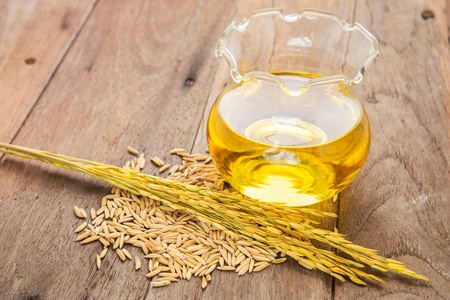
Rice bran is a bit of a Cinderella product. It has been awaiting its fairy godmother to launch it into the limelight as a valid health ingredient. Perhaps of greater benefit is its daughter, rice bran oil which clearly has credentials for health.
Rice bran is a by-product rice milling. Rice is an enormous staple for many and the bran which comes from rice when it is processed could equally offer huge pay-offs given that so much is produced. This by-product contains all sorts of components:- oil, proteins, vitamins, oryzanol, and essential minerals. There are also some interesting enzymes and even insects which are found within the bran. Whether the insects are of any benefit is another matter but for some it indicates the presence of some disturbing, harmful contaminants.
Rice bran fiber has exceptional adsorption and swelling properties. It could serve like all fibre-based functional food additives for the prevention of cardiovascular disease and obesity and as a prebiotic (Nandi & Ghosh, 2015). The rice bran polysaccharides (RBP) are the main components in rice bran. They form an heterogeneous mix of complex polysaccharides, which are mainly composed of galactose, arabinose, rhamnose, glucose and some other rarer momosaccharides (Wang et al., 2015). Incidentally, the bran is not directly responsible for the cholesterol lowering benefits that it is sometimes touted for – that honour is reserved for the oil.
The oil is perhaps of greatest interest at the moment. Rice bran oil contains 0.1–0.14% vitamin E vitamers (Kato et al., 1981; Sayre and Saunders, 1990) and 0.9–2.9% oryzanol (Okada and Yamaguchi, 1983). Compared to other culinary oils, it has a rich content of tocotrienols which are important analogs of tocopherol. These tocotrienols have been examined in human clinical studies (Qureshi et al., 1991) bolstered by the animal studies animals (Qureshi et al., 1984, 1986, 1987). Tocotrienols have anti-cholesterolaemic benefits – inhibition of cholesterol synthesis and a lowering of blood serum cholesterol (Most et al., 2005).
Oryzanol is a mixture of esters of ferulic acid with sterols and triterpene alcohols. This component offers undoubted antioxidant properties similar to vitamin E (Sayre and Saunders, 1990) – the solubility in oil is vital ! Oryzanol is claimed to promote human and animal growth, improve cardiovascular health by easing blood circulation, and influence or even stimulate hormonal secretion (Okada and Yamaguchi, 1983).
The oil has a high flashpoint which makes it very valuable as a frying oil. It could compete with rapeseed oil because of this and its potential cheapness. The oil has a balanced linoleic and oleic acid level, a low level of linolenic acid with a high level of antioxidants (Yuki and Ishikawa, 1976) due to a more even balance between the various fatty acids.
In rice milling, the bran portion is abraded i.e. it is scraped or worn away by friction forces. In that instance, lipases and ‘neutral’ oil are brought into contact, with glycerol and free fatty acids produced as a result of subsequent reactions. The whole process was exacerbated by the presence of insect damage. This type of processing was of little value given the oil which might have nutritional use was clearly unusable when broken down (Loeb et al., 1949). It was realised in the mid-20th Century that until rice bran oil was stabilised during processing, could any of this valuable ingredient be released.
Stabilization of the rice bran oil is now achieved by heating with an extruder oven, especially an extruder or in some cases by microwave heating. Rapid freezing and chemical treatment block enzymatic hydrolysis of the oil which helps with keeping it at its peak condition. The only other issue to contend with is oxidation as part of the process of rancidity. Deaeration is now employed to improve this aspect because oxidation will cause destruction of vitamin E given the vitamers are powerful antioxidants.
Products.
Please note this article contains links to our affiliate marketing partner. Please consult our affiliate disclosure.
References
Kato, A., Tanabe, K., and Yamaoka, M. (1981) Esterified tocopherols and tocotrienols in rice bran oil, soybean oil and sesame oil. Yukagaku 30 pp. 515–516.
Loeb, J.R., Morris, N.J., and Dollear, F.G. (1949) Rice bran oil. IV. Storage of the bran as it affects hydrolysis of the oil. J. Am. Oil Chem. Soc. 28 pp. 738–743
, , . (2005) Rice bran oil, not fiber, lowers cholesterol in humans. Am. J. Clin. Nutr. 81(1) pp. 64–8.
, . (2015) Studies on functional and antioxidant property of dietary fibre extracted from defatted sesame husk, rice bran and flaxseed. Bioactive Carbohydr. Diet Fibre 5(2) pp. 129–36.
Okada, T. and Yamaguchi, N. (1983) Antioxidant effect and pharmacology of oryzanol. Yukaku 32 pp. 305–310
Qureshi, A.A., Burger, W.C., Peterson, D.M., and Elson, C.E. (1986) The structure of an inhibitor of cholesterol biosynthesis isolated from barley. J. Biol. Chem. 261 pp.10544–10550.
Qureshi, A.A., Crenshaw, T.D., Abuirmeileh, N., Peterson, D.M., and Elson, C.E. (1987) Influence of minor plant constituents on porcine hepatic lipid metabolism: impact on serum lipids. Atherosclerosis 64 pp. 109–115.
Qureshi, A.A., Prentice, N., Din, Z.Z., Burger, W.C., and Elson, C.E. (1984) Influence of culture filtrate of trichoderma viride and barley on lipid metabolism of laying hens. Lipids. 19 pp. 250–257.
Qureshi, A.A., Qureshi, N., Wright, J., Shen, Z., Kramer, G., Gapor, A., Chong, Y., DeWitt, G., Ong, A., Peterson, D., and Bradlow, B. (1991) Lowering of serum cholesterol in hypercholesterolemic humans by tocotrienols (palmvitee). Am. J. Clin. Nutr. 53 pp. 1021s–1026s
Sayre, R.N. and Saunders, R.M. (1990) Rice bran and rice bran oil. Western Regional Research Center, ARS, US Dept. of Agriculture Albany, California.
, , , . (2008) Purification and identification of a novel heteropolysaccharide RBPS2a with anti-complementary activity from defatted rice bran. Food Chem. 110(1) pp. 150–5
Yuki, E. and Ishikawa, Y. (1976) Tocopherol contents of nine vegetable frying oils, and their changes under simulated deep-fat frying conditions. J. Am. Oil Chem. Soc. 53 pp. 673–676

Leave a Reply